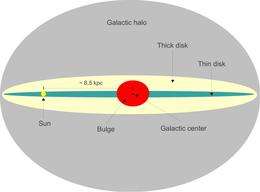Thick disk

The thick disk is one of the structural components of several galaxies, including the Milky Way. It was first proposed as a unique galactic structure, different from the thin disk and the halo in an 1983 article by Gilmore & Reid.[1] It is supposed to dominate the stellar number density between 1 to 5 kiloparsecs (3.3 to 16.3 kly) above the Galactic plane[1] and is composed almost exclusively of older stars. Its chemical composition and kinematics (those of the stars comprising it) are also said to set it apart from the thin disk.[2][3] Stars within the thick disk may be called old-disk stars. Compared to stars in the thin disk, these typically have a significantly lower levels of metals—that is, the abundance of elements other than hydrogen and helium.[4]
The thick disk is a source of early kinematic and chemical evidence for a Galaxy's composition and thus is regarded as a very significant component for understanding Galaxy formation.
Origin
Various scenarios for the formation of this structure have been proposed, including:
- Thick disks come from the heating of the thin disk.[5]
- More energetic stars migrate outwards from the inner galaxy to form a thick disk at larger radii.[6][7]
- It is a result of a merger event between the Milky Way and another dwarf galaxy.[2]
- Multiple small galactic mergers disturb stars from the thin disk so that progressively older stars are scattered out further, and even more so, far from the galactic center.[8]
- The disc forms thick at high redshift with the thin disc forming later [9]
Dispute
Although the thick disk is mentioned as a bona fide galactic structure in numerous scientific studies and it's even thought to be a common component of disk galaxies in general,[10] its nature is still under dispute.
The view of the thick disc as a single separate component has been questioned by a series of papers that describe the Galactic disc with a continuous spectrum of components with different thicknesses.[11][7][12]
See also
- Thin Disk
- Galaxy formation and evolution
- Galactic coordinate system
- Galactic bulge
- Disc galaxy
- Spiral arm
- Galactic halo
References
- 1 2 Gilmore, G.; Reid, N. (1983). "New light on faint stars. III - Galactic structure towards the South Pole and the Galactic thick disc". Monthly Notices of the Royal Astronomical Society. 202 (4): 1025. Bibcode:1983MNRAS.202.1025G. doi:10.1093/mnras/202.4.1025.
- 1 2 Bensby, T.; Feltzing, F. (2009). "The Galactic thin and thick discs in the context of galaxy formation". Proceedings of the IAU Symposium. 265: 300. arXiv:0908.3807
 . Bibcode:2010IAUS..265..300B. doi:10.1017/S1743921310000773.
. Bibcode:2010IAUS..265..300B. doi:10.1017/S1743921310000773. - ↑ Kordopatis, G.; et al. (2011). "A spectroscopic survey of thick disc stars outside the solar neighbourhood". Astronomy & Astrophysics. 535: A107. arXiv:1110.5221
 . Bibcode:2011A&A...535A.107K. doi:10.1051/0004-6361/201117373.
. Bibcode:2011A&A...535A.107K. doi:10.1051/0004-6361/201117373. - ↑ Freeman, K. C. (2010). "The HERMES Project: Reconstructing Galaxy Formation". In Block, D. L.; Freeman, K. C.; Puerari, I. Galaxies and their Masks: A Conference in Honour of K.C. Freeman, FRS. Springer. p. 319. Bibcode:2010gama.conf..319F. doi:10.1007/978-1-4419-7317-7_27. ISBN 978-1-4419-7316-0.
- ↑ Steinmetz, M. (2012). "The Galactic thin and thick disk". Astronomische Nachrichten. 333 (5-6): 523. arXiv:1205.6098
 . Bibcode:2012AN....333..523S. doi:10.1002/asna.201211698.
. Bibcode:2012AN....333..523S. doi:10.1002/asna.201211698. - ↑ Schoenrich, R.; Binney, J. (2009). "Chemical Evolution with Radial Migration" (PDF). Monthly Notices of the Royal Astronomical Society. 396 (1): 203–222. arXiv:0809.3006
 . Bibcode:2009MNRAS.396..203S. doi:10.1111/j.1365-2966.2009.14750.x.
. Bibcode:2009MNRAS.396..203S. doi:10.1111/j.1365-2966.2009.14750.x. - 1 2 Loebman, S.; et al. (2011). "The Genesis of the Milky Way's Thick Disk via Stellar Migration". The Astrophysical Journal. 737 (1): 8. arXiv:1009.5997
 . Bibcode:2011ApJ...737....8L. doi:10.1088/0004-637X/737/1/8.
. Bibcode:2011ApJ...737....8L. doi:10.1088/0004-637X/737/1/8. - ↑ Fohlmeister, J. (24 April 2015). "The riddle of galactic thin–thick disk solved". Phys.org. Retrieved 24 May 2015.
- ↑ Brook, C. B; Kawata, D.; Gibson, B. K.; Freeman, K. C. (2004). "The Emergence of the Thick Disk in a CDM Universe". The Astrophysical Journal. 612 (2): 894. arXiv:astro-ph/0405306
 . Bibcode:2004ApJ...612..894B. doi:10.1086/422709.
. Bibcode:2004ApJ...612..894B. doi:10.1086/422709. - ↑ Yoachim, P.; Dalcanton, J. (2012). "Structural Parameters of Thin and Thick Disks in Edge-On Disk Galaxies". The Astronomical Journal. 131 (1): 226–249. arXiv:astro-ph/0508460
 . Bibcode:2006AJ....131..226Y. doi:10.1086/497970.
. Bibcode:2006AJ....131..226Y. doi:10.1086/497970. - ↑ Schoenrich, R.; Binney, J. (2009). "Origin and Structure of the Galactic Disc(s)". Monthly Notices of the Royal Astronomical Society. 399 (3): 1145–1156. arXiv:0907.1899
 . Bibcode:2009MNRAS.399.1145S. doi:10.1111/j.1365-2966.2009.15365.x.
. Bibcode:2009MNRAS.399.1145S. doi:10.1111/j.1365-2966.2009.15365.x. - ↑ Bovy, J.; Rix, H.- W.; Hogg, D. W. (2012). "The Milky Way Has No Distinct Thick Disk". The Astrophysical Journal. 751 (2): 131. arXiv:1111.6585
 . Bibcode:2012ApJ...751..131B. doi:10.1088/0004-637X/751/2/131.
. Bibcode:2012ApJ...751..131B. doi:10.1088/0004-637X/751/2/131.
External links
- Thin and Thick Galactic Disks
- Structure and Evolution of the Milky Way
- Populations & Components of the Milky Way